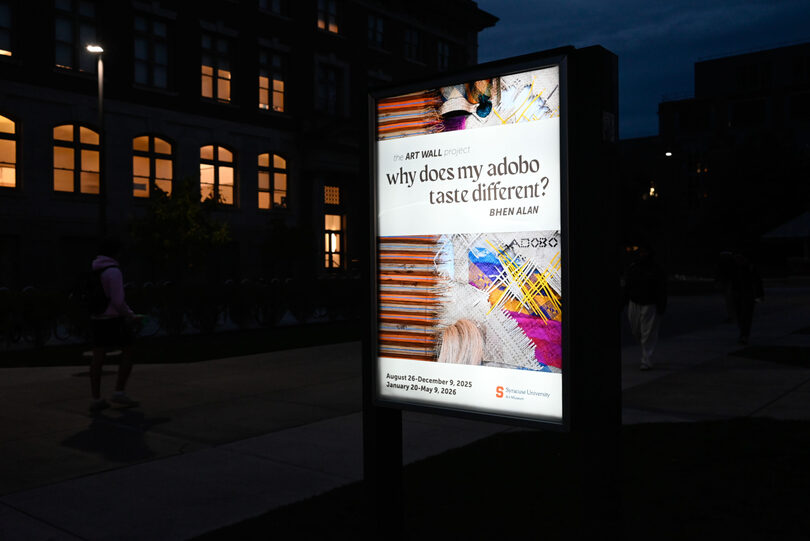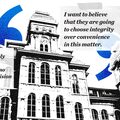New SU art exhibit weaves kinship, Filipino food into immigrant experience narrative

Alan’s woven works represent more than just the pictures they create. The labor-intensive process of weaving represents community and care, the artist said. Christan Calabrese | Asst. Photo Editor
Get the latest Syracuse news delivered right to your inbox.
Subscribe to our newsletter here.
Artist Bhen Alan tries to remember everything through tasting it. After immigrating to Canada at 17, Alan began to notice that his food didn’t taste the same as it did in the Philippines. Now a Hamilton, N.Y. local, that experience inspired his recent work at the Syracuse University Art Museum.
“Looking at that slippage of the tongue, of the memories of trying to taste something, but also not tasting,” Alan said. “I really wanted to anchor it through food and anchor it through the disruption of that taste and the disruption of that tongue.”
Alan’s exhibit “Why Does My Adobo Taste Different?,” is the fifth installation of the Art Wall Project at the SU Art Museum. His piece is a collage of interconnected weavings and materials spanning the wall at the front of the museum. The exhibit is on display all school year.
Melissa Yuen, a curator at the museum, said the Art Wall Project is a space for contemporary artists to display work during the full academic year with the intention of sparking interdisciplinary conversations.
Alan’s piece delves into the immigrant experience through the lens of food.
“The immigrant’s lived experience, and really thinking about how family and materials derived from one’s homeland can be used to repair the traumas that one would experience during this immigration process,” Yuen said.
Alan’s father died when he was 2 years old, and his mother moved to Taiwan when he was seven to provide for him, leaving him in the care of his grandmother. Later, after moving to Canada with his mother, Alan said he felt completely alone and had only himself, his artwork and his food.
When he first started school, classmates looked at him weirdly for the food that he ate, so he stopped packing the food of his childhood and instead switched to food others would find acceptable.
“But then that small disruption became something bigger,” Alan said. “I’m not just changing my food, but I’m changing my values, I’m changing my beliefs and, therefore, I’m changing my identity.”
Alan was forcefully forgetting who he was to become “Americanized,” he said. The change extended past his food to things like body language and gestures. Alan’s experience is part of the puzzle of colonization, Yuen said.
“Really by looking at that intensely personal experience for him, it’s also a work that comments on global imperial entanglements as well, and the history of globalization and imperial conquest,” Yuen said.
The piece took a year to create, and it wasn’t just spent weaving. Alan also wrote a lot and interviewed people about how they experienced cultural differences.
After going back to the Philippines to research and collect materials, Alan looked for differences in flavor between his family’s cooking and his back in the United States. He then transferred that to differences in texture and technique in his weaving.
“The first thing that we do is we eat, because we want to remember,” Alan said. “And even though the flavor is different, we have each other to remember through.”
It was this idea of community that Alan wanted to translate into his weaving — he wants his viewers to experience a moment of connection. The weaving highlights the importance of memory, family and kinship, Yuen said.
A section of the wall is dedicated to a reweaved painting of Alan’s grandmother. The reweaved technique represents his tumultuous feelings about his family. His guilt and anger led him to initially rip the painting apart, but weaving the canvas back together acted as reconciliation.
“I still want to tell her I love her, and I care for her, and even though I’m in a different space now she’s still in my mind,” Alan said. “And that’s why the weaving happened, as a way to reconcile, as a way to remember, as a way to go back into the space where she is.”
Dr. Yuen reflected on this portrait as her favorite component of the piece.
“So when you look at two of these elements, we really see the grid and the warp and the weft of the weaving. But then if you know where to look, you will see her face emerging,” Yuen said.
Claire Halasi-Kun, a freshman industrial design major, said the piece resonated with her because of the various textures and tiny details. The most prominent part of the piece was the grasses, but she found the word “adobo” hidden throughout. Adobo is a traditional Filipino stew that Alan refers to as the unofficial national dish of the Philippines.
Ingredients of adobo, like suka, toyo and bawang, are also woven into the piece, and the tactile nature of the piece stood out to her.
“I really like the interaction of it,” Halasi-Kun said. “How textured it was, both visually and literally.”
Alan said the care for material and communal aspects of weaving created the two core themes of his piece: connection and reflection. He loved the ability to bring aspects of Filipino cooking to Syracuse, specifically the soy sauce his uncle created.
“It’s not available in that space at the museum, it’s not available in Syracuse, it’s not available in the U.S,” Alan said. “But it could be available on that weaving, and it could be available in that memory.”






